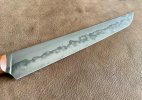- Joined
- Feb 16, 2022
- Messages
- 615
TL;DR what sand paper do you guys use for blades above going from 1000 grit and above?
I've been working on a bunka honyaki (a medium sized kitchen knife similar to a santoku with a hamon) and I've been stuck on the polishing stage for about 2 weeks now specifically at around the 1000 to 1500 point in my progression.
I've had to start over a couple times because the knife will end up with a random scratch from setting it down, and just handling it in general. So that's part of the problem. The other part of the problem is that the 3m wetordry slows down significantly after 800 grit.
I use 3m cubitron up until 320 grit then go over to 3m wetordry which is fine because I normally don't mirror polish.
I've tried taking it over to the buffing wheels a few times, but even at 1000, and 1500 my coarsest buffing compound seems to have trouble getting the scratches out.
So I'm starting to get a bit desperate now, because I want to move forward with this project. So does anyone have any better >1000 sandpaper, and what does your mirror polish progression look like for hardened steel?
I've been working on a bunka honyaki (a medium sized kitchen knife similar to a santoku with a hamon) and I've been stuck on the polishing stage for about 2 weeks now specifically at around the 1000 to 1500 point in my progression.
I've had to start over a couple times because the knife will end up with a random scratch from setting it down, and just handling it in general. So that's part of the problem. The other part of the problem is that the 3m wetordry slows down significantly after 800 grit.
I use 3m cubitron up until 320 grit then go over to 3m wetordry which is fine because I normally don't mirror polish.
I've tried taking it over to the buffing wheels a few times, but even at 1000, and 1500 my coarsest buffing compound seems to have trouble getting the scratches out.
So I'm starting to get a bit desperate now, because I want to move forward with this project. So does anyone have any better >1000 sandpaper, and what does your mirror polish progression look like for hardened steel?

